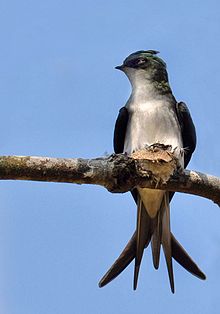Grey-rumped treeswift
| Grey-rumped treeswift | |
|---|---|
 |
|
| Scientific classification | |
| Kingdom: | Animalia |
| Phylum: | Chordata |
| Class: | Aves |
| Order: | Apodiformes |
| Family: | Hemiprocnidae |
| Genus: | Hemiprocne |
| Species: | H. longipennis |
| Binomial name | |
|
Hemiprocne longipennis (Rafinesque, 1802) |
|
The grey-rumped treeswift (Hemiprocne longipennis) is a species of bird in the Hemiprocnidae family. There are currently four extant species in the family. Like the other members of Hemiprocnidae, this species is closely related to true swifts as well. However, unlike true swifts, the treeswifts are arboreal in nature, often seen perched on trees, high tension power transmission lines and on pylons. When perched, the wing tips cross over the tail. This species is commonly found in peninsular Malaysia but has an extremely large range with limited information about the population trend,.
Adult male with a distinct dark grey throat and chest contrasting with a white belly.Ear coverts are dull orange red/chestnut colored. Adult female lacks the dull orange red/chestnut coloration on the ear coverts. When perched the wing tips cross over across the tail. Both sexes have a greenish sheen to the upper parts.
It is found in Brunei, Indonesia, Malaysia, Myanmar, the Philippines, Singapore, and Thailand. Its natural habitats are subtropical or tropical moist lowland forests, subtropical or tropical mangrove forests, and subtropical or tropical moist montane forests
The birds occasionally catch insects in flight by sallying from perches. They build nests on tree branches. The half-saucer shaped nest is made from hardened saliva interspersed with feathers, mosses and/ or flakes of tree bark. The single egg is reportedly attached to nest surface with saliva. Owing to the fragile nature of the nest, it is attached only on one side to the branch. Thus, the bird does not sit directly on the nest for incubation. Similarly, it is also reported that the parent birds brooded by perching on the branch above the nest and fluffing their breast feathers out to cover it.
...
Wikipedia

